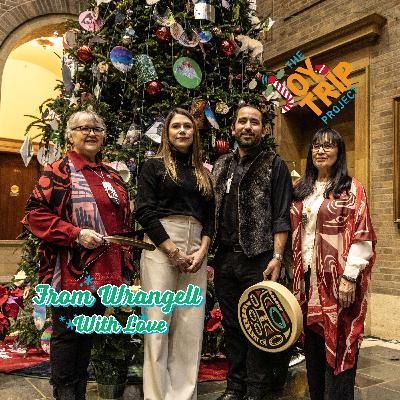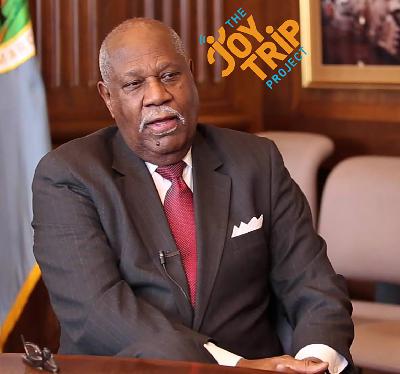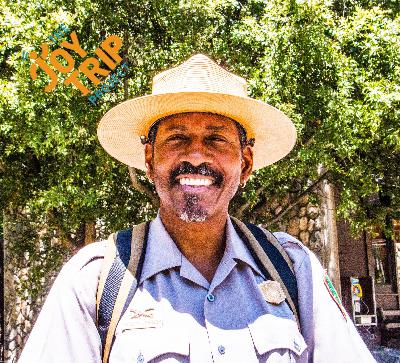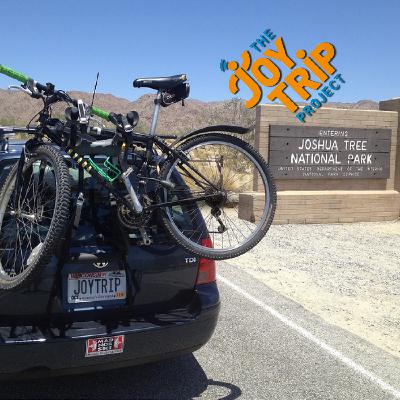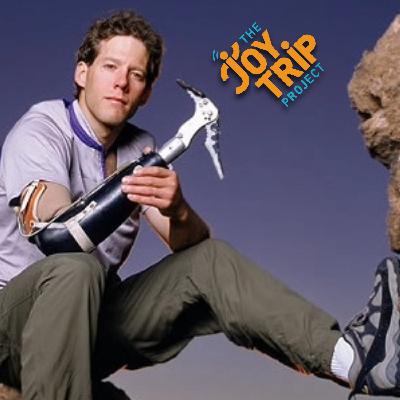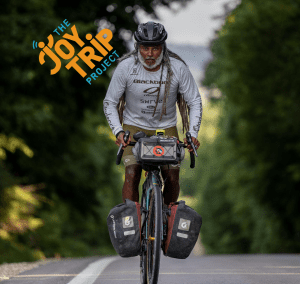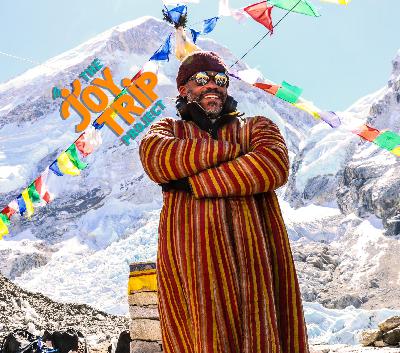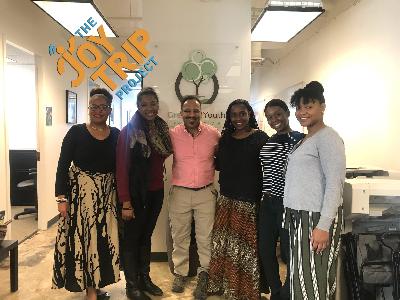Discover The Joy Trip Project
The Joy Trip Project

The Joy Trip Project
Author: James Edward Mills
Subscribed: 36Played: 183Subscribe
Share
©The Joy Trip Project 2024
Description
The Joy Trip Project is a continuing story sharing enterprise dedicated to outdoor recreation, environmental conservation, acts of charitable giving and practices of sustainable living
111 Episodes
Reverse
In 2024 the U.S. Capitol Christmas Tree was harvested and delivered from the Tongass National Forest of Wrangell Alaska. For the tenth year in a row, I had the rare privilege to be the official photographer of The People’s Tree. In cooperation with the U.S. Forest Service and the Society of American Foresters we brought an 80-foot Sitka Spruce to the west lawn of the U.S. Capitol Building on a journey of more than 4,000 miles. Taking pictures along the way, we also gathered audio and video to tell this amazing story. In this special edition of the Joy Trip Project Podcast in three acts, we bring you the sounds and voices of our travels on the trail of a gift from the lands of Tlingit People.
After 16 years of production, the Joy Trip Project has worked hard not to endorse political candidates. With a single exception in the last Wisconsin Senate race, I’ve intentionally kept my opinions to myself. As a professional journalist, it is my obligation not to reveal my personal bias regarding any political party or partisan issue. Instead, it is my job to report on the events of our world in as objective a manner as possible. Even in this incredibly divisive and polarizing campaign season, I have recounted few details on the respective candidacies of former President Donald Trump and Vice President Kamala Harris. Although I’ll vote for one candidate, based on my personal beliefs publicly, I’ve been silent on these matters. That’s not going to change. As a news organization it is our duty to convey to our audience the facts of any story with neither bias nor prejudice so that one can draw their conclusions, and cast their vote based on the information we’ve gathered.
Since we tend to focus on issues of environmental preservation, I believe that a summary of the two candidates’ history of protecting the natural world can best serve the interests of our readers and listeners.
Donald Trump and Kamala Harris have strikingly different records on the environment.
The protection of public land requires the broad ranging vision and leadership of federal service professionals at the highest levels. As the 19th Director of the National Park Service Charles F. Sams III is guiding the management of a complexed agency that oversees the protection of 63 National Parks and more than 420 individual monuments, battlefields, lakeshores and grasslands. A member of the Confederate Tribes of the Umatilla Indians, Sams is the first Native American to serve as the administrator of the memorial sites that preserve our natural history and enduring national heritage.
When the folks at the Public Broadcasting Service went looking for a charismatic personality to host their latest documentary film series on the natural world, they reached out to a man with just the right skills to bring the outdoors into every home in America.
Baratunde: My name is Baratunde Thurston. I am a multimedia storyteller operating at the intersection of race, technology, democracy and climate. Because I love this planet.
The wild. There's nothing quite like the feeling of stepping outside. And breaking free from the modern world. I'm in northern Minnesota, on the edge of a lake that resembles an ocean. In places like this, it's easy to see nature as something so powerful, so vast.
We could never leave a real mark on it. But our footsteps are almost everywhere these days. And while knowing that can weigh you down, it can also lift us up and inspire us to change.
JTP: The show airs on PBS television stations nation-wide. And like its host, the program explores those points of connection where the outdoors and the human experience come together for fun, adventure and environmental conservation. Each episode introduces viewers to remarkable people and places from one end of this great nation to other. In advance of the premiere of this amazing new series I had the chance to talk to Baratunde Thurston and get an inside look into America Outdoors.
The PBS Series America Outdoors is coming to your favorite Public Television station. Check your local listings for dates and times near you. Baratunde Thurston is the author of the book “How to be Black” and he’s the host the “How to Citizen” Podcast. You can learn more about him and all his amazing work at Baratunde.com
Our Music comes courtesy of Artlist featuring the talents of The Cliff
The Joy Trip Project is made possible thanks to the support of the Schlecht Family Foundation and the National Geographic Society. You can follow along on this and other journeys through history at Joytripproject.com.
If you enjoyed this episode, please drop me a note in the comments or better still write a review on one of our many stream platforms including iTunes, Stitcher, Spotify and Google Podcasts. I’d love to hear from you. You can also reach me via email with your constructive questions, comments and criticisms at info@joytripproject.com
A few weeks before his 80th birthday, I had the rare pleasure to speak by phone to the 15th director of the National Park Service Robert Stanton. From his home in Maryland, Mr. Stanton shared with me a personal history of his career as a leading figure in the preservation of public land as well as the enduring legacy of our heritage as a nation. Born in 1940, as Black American Stanton was subjected to the racially focused prohibitions of the Jim Crow era that denied him access to many of the national parks and monuments that he would grow up to manage. And though he and his family were restricted from the recreational spaces where white Americans were free to travel, Stanton was able from an early age to experience the wonders of nature.Stanton: I grew up in rural segregated Texas, and we came from very meager means, so we did not vacation. I was in the cotton fields or the hay fields during my young adulthood. But I was not a stranger, if you will, to the out of doors, you know, with bare feet running through the woods, fishing in the lakes, gravel pits, taking a little dip in our birthday suits and what have you and watching out for the copperheads and water moccasins. But so, no the out of doors were not a stranger to me.JTP: It was during his childhood that policies that had restricted Black Americans from visiting national parks were slowly beginning to lift. Under the administration of President Franklin Delano Roosevelt around the end of the Second World War progressive shifts in the nation’s attitude toward Black Americans became a bit more favorable, despite the objections of many state legislators and private citizens.
Stanton: In terms of my exposure to the National Park Service and other land management agencies and putting it in sort of historical context, you recognize the courage on the part of Harold Ickes, Secretary of the Interior, and Roosevelt, when he issued his secretarial order in 1945, saying that there will not be any discrimination in the national parks. My understanding is that when he made the decision that the proprietors of restaurants and overnight accommodations surrounding the gateways to the parks, they raised holy hell. “You mean you're going to allow them colored folks to come in and eat and sleep where they want to in the park?”JTP: It could be said that first battle lines of modern Civil Rights Movement were drawn in our national parks. By order of Secretary of the Interior Harold Ickes in 1945, these public recreation areas were among the first sites to be desegregated nation-wide. It was through the leadership and encouragement of social activists within the Roosevelt Administration and then under President Harry S. Truman that Ickes ordered that the National Parks be made open to everyone regardless of race or ethnicity.Stanton: But the thing I would bring to your attention, which was not widely advertised, is that he had the counsel of two prominent, forceful, unrelenting Black executives who were promoting the integration in full accessibility of not only to Park Service citizen programs, but throughout the breadth of the programs at Interior. The first one was Robert Weaver, who became the first African-American to serve as a Cabinet Secretary at HUD appointed by President Johnson. He was followed by William Trent Jr.. And it is William Trent Jr. who was really a strong advocate that here you have young men returning from World War II and they need to have some way in which they could just sort of relax themselves. Coming from the war, even though we were coming back to places they were not permitted to enter, such as cafes and restaurant, but still they should have an opportunity to enjoy some of the benefits of being an American citizen. JTP: Civil Rights leaders during the presidency of Franklin Roosevelt through the 1940s became known as the Black Cabinet or the Federal Council of Negro Affairs. The phrase was coined by Dr. Mary McLeod Bethune in 1936 and as group that incl...
Long before the National Park Service was established, the geological site commonly known as Mammoth Cave in the state of Kentucky was a popular tourist attraction. Open to the public for guided tours beginning in 1830’s this massive labyrinth of underground caverns and tunnels was first explored by enslaved people whose legacy of stewardship spans more than 5 generations. A Black man named Stephen Bishop lead much of the earliest explorations of the cave system and named many of the most prominent features. An expert on the largest cave in the world that winds more than 406 miles beneath the Earth’s surface, Bishop was said to have guided the most prominent scientists, political figures and writers of the mid-19th century including the poet Ralph Waldo Emerson. It was on a visit to Mammoth Cave guided by Bishop in 1857 that Emerson wrote the essay Illusions, inspired by a feature called the Star Camber.
During the global Covid-19 Pandemic one of my favorite programs to watch on television was the Cinemax miniseries called “Warrior”. Set in San Francisco’s Chinatown during the late 1870s, this amazing show, inspired by the writings of Bruce Lee, is an action packed period drama that depicts the realities of anti-Asian racial oppression along with the furious fists of Kung Fu fight scenes. One of the main characters in this exciting series is Father Jun, the leader of the City's most powerful gang or tong, played by the New York-based actor Perry Yung.
His portrayal of this hard-edged and often violent leader is so captivating I began an instant fan. By an odd coincidence Yung and I just happen to have a mutual friend on Facebook. After getting acquainted online I also discovered that he is a passionate advocate for the resistance to the rise of hostility toward Asian people and the climate of hatred being perpetuated by white supremacists nationwide. As a master of the performing arts Yung uses his talents to personify prototypical roles of Asian men to give them Both depth and texture far beyond the cliched stereotypes so often presented by Hollywood.
In his latest film “Boogie”, Yung plays the father of the title character, a young man who struggles with his identity as an Chinese-American basketball player with NBA aspirations at the intersection of the Black and Asian communities of the modern era. Yung and I spoke over Zoom not long before the mass murder of 6 Asian women in Atlanta. In addition to the parallels between the current state of anti-Asian sentiment of today and the violence and oppression of the past, Yung and I discussed his long career as both an actor and the maker of the traditional Japanese flute called the Shakuhachi.
You can learn more about Perry Yung on his website at PerryYung.wordpress.com. In light current climate of racism and bigotry across America, I want to encourage everyone to seek out and experience cultures of every variety. Buy their art, learn their language, eat their food watch their media and demand of all those around you to stop the hate.
Music this week comes courtesy of Artlist featuring the work of Ian Post and the group Kodo. The opening was the theme music of the Cinemax series Warrior, by Reza Safinia and H. Scott Salinas.
The Joy Trip Project is possible thanks to support of Patagonia, Yeti, Seirus Innovations, Outdoor Research and a grant from the National Geographic Society.
Thanks for listening, but you know I want to hear from you. So please write a note in the comments or via email at info@joytripproject.com. If you enjoyed this conversation write a review on Apple Podcast, Google Podcasts, Spotify or Stitcher. There you’ll find past episodes going back more than a decade. Let me know what you think.
For now, go be joyful. And Until next time. Take care!
Even though we might be seeing the back end of the global Covid-19 Pandemic many of us are still stuck at home wading through endless meetings over Zoom and other teleconferencing platforms. With the hopes of creating a little community spirit and to encourage folks out there to step away from their screens and maybe crack open a book instead, I started a little group called the Joy Trip Reading Project. Each month we’re taking a deep dive into stories of primarily Black authors whose work centers around nature and the identity many of us share in common as people who love the great outdoors.
In February, for Black History Month, the title we read was Gloryland, by National Park Ranger Shelton Johnson. This novel is the story of a Black American sergeant in the United States Army at the turn of the last century. As a member of the Buffalo Soldiers, the principle character, Elijah Yancy, reveals to us the life and times of the men who were among the world’s original protectors of public land at the National Parks of Yosemite and Sequoia. Not enough people know that in 1903 the first superintendent of Sequoia was a Black American U.S. Cavalry officer by the name of Captain Charles Young. Despite the national climate of Jim Crow segregation these men were among our first National Park Rangers During a time when race relation in this country were at their most abysmal, the Buffalo Soldiers fought to preserve the best idea America ever had.
Unfortunately, because of some technical difficulties connecting with Ranger Johnson over Zoom I literally had to hold my cellphone up to my computer microphone to conduct this interview. Sorry in advance for the marginal sound quality, but under the circumstances, really can you do? I’m James Edward Mills and you're listening to the Joy Trip Project.
[/vc_column_text]
[/vc_column_inner][/vc_row_inner]
Music courtesy of Artlist featuring the band Muted, Steve Poloni and Ty Simon.
[/vc_column][/vc_row]
The Joy Trip Project is made possible thanks to support of Seirus Innovation and Outdoor Research.
This recording of the Joy Trip Reading Project was created in partnership with University of Wisconsin Madison Nelson Institute For Environmental Studies. Here we acknowledge the ancestral homeland of the Ho-Chunk People on the sacred land known for time and memorial as DeJope. Wherever you are in North American please recognize the native people of the place you now call home.
Thanks for listening, but as always, I want to hear from you so please drop me in note in the comments with your questions, comments or criticisms or write to me via email at info@joytripproject.com. You can also find me on Facebook, Instagram or Twitter. If you liked this episode please write me a review on iTunes, Stitcher, Spotify or wherever you download your favorite podcasts. For now, go be joyful and until next time. Take care.
For 34 days The United States Federal Government has been in a partial shutdown. How are our national parks coping through this period of uncertainty
In 2003 Aron Ralston was brash young man looking for adventure. But while exploring the slot canyons of the Utah desert he found himself trapped miles from home deep within a underground chasm his right arm crushed and pinned by a massive boulder. There he lay stranded with no hope of rescue for five days. Rolston’s story was portrayed in the 2010 film 127 Hours starting James Franko.
Actor James Franco as Aron Ralston in the film 127 Hours
In order to escape from circumstance that would have meant certain death Ralston was forced to amputate his own arm. But he would go one to inspire millions through his incredible story of survival and perseverance through his bestselling book Between a Rock & a Hard Place. Ralston was the keynote speaker at the bi-annual meeting of the Conservation Alliance during 2012 Outdoor Retailer Summer Market in Salt Lake City Utah.
Immediately following his presentation I had the opportunity to ask him a few questions about his ordeal and what inspired him to live to tell his story.
JTP: Many people have seen the film and have read the book. The film is called 127 Hours. And the book is called Between a Rock and a Hard Place and it tells your story of a very harrowing experience in the Utah desert. I'll leave it to other people to get an idea as to what it is that, that story meant to them, but perhaps you can give me an idea. In the film, how accurate was James Franko's portrayal of your story? What did they get right? What did they get wrong?
Ralston: Well I worked with the film team for seven years as it was to take it all the way from when I wrote my book to turn it into a script and then selecting a director and working with them to choose James as they did to depict me and my experience. And even working with James then to coach him through the actions. He's admittedly not an outdoorsman and to get him familiar with the desert, to get him an understanding of my experience. Not that he was trying to impersonate me so much, but to take an audience through my entrapment, the psychological aspects of the ordeal that I endured and then the liberation, the release, the triumph of it all too. And I thought it was very accurately portrayed, both from the overarching emotional stories, the themes that they highlighted about love and family and also the very physical and factual aspects of it too, all wrapped up in this extraordinary film adaptation of my experience. I think that people who watch it they know what I went through. You feel it really as you watch the film. So I was extremely pleased with what they did. I was that the point where I'm watching it with my sister a couple of times and as she's seeing it for the first time she's like elbowing me and slapping me on the knee saying , "That's so you! They totally nailed it!" Even with my family they saw how genuine it was and to do that and at the same time really make a film that moves people? That's not an easy thing. You usually have to choose one or the other, but they got it both. They got this amazing film, I thought very powerful and inspiring and then also sometimes resonated with my experience that showed that genuine portrayal. Even with my faults, somethings I'm not necessarily proud of, mistakes and foibles as they are. I couldn't have been happier.
JTP: Your experience was both physically and emotionally traumatic. Can you give me an idea, can your subscribe for me what was the greatest moment of despair for you?
Ralston: I think that the darkest point of the entrapment came after I had eliminated all my options of escape and was really left with still the idea that I could amputate my arm. It's just that I wasn't desperate enough yet and then as I became more desperate on the third day I tried to cut into my arm. I couldn't even cut through the skin. I felt despair and thought I'd bottomed out at that point. But then later on the fourth day I had this kind of epiphany of sorts,
In the spirit of charitable giving Robert Egger is leading the charge in America to show that philanthropy and looking out for the best interest of others can be business as usual. Dedicated to feeding the homeless and providing job training for the formerly incarcerated Egger’s work at the D.C. Central Kitchen serves the poor in our nation’s capital.
In cooperation with restaurants and catering business, the D.C. Kitchen collects more than 3,000 pounds of surplus food each day. The non-profit makes 4,500 meals that are distributed to over 100 shelters, transitional housing facilities and rehabilitation centers throughout the Washington D.C. area. And Robert Egger travels the country giving talks on the value of philanthropic giving as an engine for social change. At the D.C. Central Kitchen Egger is using food to build stronger communities, combating hunger while creating opportunities.
The Joy Trip Project is made possible through the generous support of our sponsor Patagonia. Check out their latest new media projects and conservation initiatives at their blog the cleanest line.com.
An interview with urban
revitalization strategist Majora Carter
JTP:
Delegates from about 190 countries are gathering over the next two weeks at the United Nations Climate Change Conference in Copenhagen. Although this is a landmark event, the largest meeting ever to discuss the environmental future of our planet. I’m a little concerned that we may not be talking about the most important issues.
The other night on NPR David Kestenbaum reported on the first day of the conference. In his report on All Things Considered he said everyone pretty much agrees that we have to do something about climate change. But how I see it where the problem lies is that the delegates also seem to share the same disagreements
NPR:
In fact most of the disagreements, they’re all about money. Developing countries like Bolivia are arguing “Hey The global warming problem? you in the developed world made it. So to solve it you’re going to have to give us money to adapt and to keep our emissions down as we grow.
JTP:
The industrial growth that caused the climate change crisis in the first place will apparently continue. You see it seems that the Copenhagen delegates are really only arguing about who gets to continue to pollute the atmosphere with carbon gas emissions and how much. The conversation so far seems to be relegated to trading carbon credits for cash so the developing world can continue to build factories and produce consumer goods. But at what cost? What about the environment? And what about millions of disenfranchised people in the U.S. and around the world that will be most directly impacted as our planet’s climate continues to change in the wake of human progress?
I won’t be attending the conference in Copenhagen. But a few weeks ago I did attend the Breaking the Color Barrier to the Great Outdoors conference in Atlanta. A few hundred African American Environmentalist gathered to talk among other things about the role people of color can play in protecting the natural world. There I met Majora Carter, the 2005 winner of the MacArthur Foundation Genius Grant. She received $500,000 to developed her ideas on creating sustainable urban communities. And while we didn’t talk about Copenhagen in particular Carter has a rather unique perspective how best to curb some of the social effects of Climate Change.
Carter:
The McArthur Foundation dubbed me an urban revitalization strategist. Which I love, because of the work that I did around pioneering one of the first green jobs training systems in the country, really doing community based, led project development in one of the poorest congressional districts in the country that’s also one of the most environmentally challenged. And the idea was that you can do development that met both the environmental as well as economic needs of a very poor communities and give them the tools they need to enjoy it and be a part of its development.
JTP:
The environmental issues that our planet faces aren’t limited to carbon emissions. Though green houses gases are indeed the primary cause of global warming it’s the institutions and practices of human behavior that create them. Carter believes that we need to develop community based initiatives that produce green jobs and allow ordinary people take an active part in the cessation carbon emitting industries. In order to make lasting change in the fight again climate change we have to rethink how we develop and live in our urban centers. And for many communities around world that’s going to mean taking a hard look at issues of social justice, how we treat the urban poor as well as racial and ethnic minorities. I’m James Mills and you’re listening to The Joy Trip Project.
JTP:
There are many, many challenges that are involved in doing any kind of development in urban areas. Especially those areas where you’ve had a tremendous amount of disinvestment that started at a very high level that lead to the displacement of people or the development of lost of noxious fac...
Shattered. The broken pieces of a world torn apart by war and a planet devastated by greed and corruption lie scattered at our feet. In her new book, “Finding Beauty in a Broken World” poet and naturalist Terry Tempest Williams brings together the tattered fragments of our times into a literary mosaic of peace and reconciliation. From the charred ruins of the Twin Towers and the Pentagon on 9/11, to endangered prairie dogs of Utah, to the creation of a memorial to the 10s of thousands who died in the Rwandan genocide, Williams constructs an image of hope for a brighter future, a journey toward a time when human beings and the world they inhabit coexist with love and compassion.
This podcast is brought to you thanks to a generous grant from KEEN Footwear makers of shoes, bags and socks designed to take you wherever your Hybrid Life leads. visit www.keenfootwear.com
Hosted by James Edward Mills, this series delivers each day in the month of February a compelling audio story via podcast in about 60 seconds. Each narrative offers a brief glimpse into the life and times of Black men and women who have shaped our cultural identity. The series is called Unhidden Minute. I hope you’ll join us.
Immediately following my return from Washington D.C. - I mean on the flight home – I was inundated with kind words of support and condolences for the demise of my Christmas Tree. Due to excessively high winds early in last week of November 2023, it is indeed true that the beautifully decorated holiday tree provided to the White House by the National Park Service sadly fell over. News reports in photographs showed the tree lying on its side. But as I graciously replied to each of these thoughtful notes, I found great comfort in the knowledge that the 63-foot Norway Spruce I had followed from the Monongahela National Forest of West Virginia to our nation’s capital, The People’s Tree, stood proudly on the west lawn of the U.S. Capitol Building.Immediately following my return from Washington D.C. - I mean on the flight home – I was inundated with kind words of support and condolences for the demise of my Christmas Tree. Due to excessively high winds early in last week of November 2023, it is indeed true that the beautifully decorated holiday tree provided to the White House by the National Park Service sadly fell over. News reports in photographs showed the tree lying on its side. But as I graciously replied to each of these thoughtful notes, I found great comfort in the knowledge that the 63-foot Norway Spruce I had followed from the Monongahela National Forest of West Virginia to our nation’s capital, The People’s Tree, stood proudly on the west lawn of the U.S. Capitol Building.
For those of us who really love bicycles, I think what we enjoy most is the sense of freedom we get from travel on the open road under our own power. This mechanical device allows us to engage both our minds and bodies to pedal long distances on just two wheels so that we can explore the landscape of the modern world. But through our journeys over lightly trafficked rural roads, as we roll past obscure old towns and villages, we can also reveal the compelling memories of the not-so-distant past. As a modern-day explorer, there's a man who rides a bike along gravel paths and asphalt highways across time and space and into the pages of history.
Erick Cedeño: My name is Eric Cedeño. Some people know me as the Bicycle Nomad.
JTP: For many years, Eric Cedeño has traveled thousands of miles by bicycle across North America. As a cyclist carrying his own gear from one town to the next, he reimagines the excitement and enthusiasm of human powered transportation toward the end of the 19th century. Back then, even the United States Army thought that the bicycle might change how human beings travel from place to place.
Erick Cedeño: There was a big craze. People were going crazy about the bicycle, the technology, about the bicycle. And the army realized that they needed other methods of transportation to be successful. They only had the cavalry back then, and they knew that bicycles were cheaper than horses. Easier to maintain than a horse. They could go further than a horse could. And also, there were quite in battlefields. So they understood the power of the bikes and they wanted to adapt a bicycle corps.
JTP: In 1896, U.S. Army Lieutenant James Moss came up with the idea to conduct an experiment to see if the bicycle could one day be used to replace the horse. In order to prove the concept, moss recruited a platoon of 20 soldiers.
Erick Cedeño: Fort Missoula, Montana, is where that was formed. Lieutenant Moss approached the Army and says, I have the perfect man to do this experiment. And he did. Luckily for him, he had the Buffalo Soldiers out of the 25th Infantry out of Fort Missoula.
Erick Cedeño The Bicycle Nomad
photo by Josh Caffrey
JTP: At the time, more than 30 years after the end of the Civil War, there were stationed there an all-Black unit of enlisted men known collectively as the Buffalo Soldiers. These men who fought the Plains Wars of westward expansion and sadly participated in the displacement of Native people, were given the opportunity for a peacetime mission into the American heartland. Led by Lieutenant Moss, a white officer. Over the next two years, from 1896 to 1897, the Buffalo Soldier Bicycle Corps would make three expeditions across the West. In 2022, Eric Cedeño retraced the route that they traveled from Fort Missoula, Montana, to Saint Louis, Missouri. The distance of more than 1900 miles. In the retelling of their story through physical reenactment, the Bicycle Nomad takes us on a journey back in time. In his travels following the path of the Buffalo Soldiers, Cedeño not only celebrates the accomplishments of black Americans from our past, but also inspires further exploration of our history that is too often overlooked. I'm James Edward Mills, and you're listening to The Joy Trip Project.
Title photo by Josh Caffrey
Erick Cedeño in Missouri
photo by Josh Caffrey
Erick Cedeño's passion for exploration began at a very early age.
Erick Cedeño: Since I was a kid, I've always loved history. And I have a story where my mom took me to Mexico to see the pyramids of the Mayan and Aztec civilization. We went to Mexico just for that. She hired a tour guide that took us and told us the history. Now, I'm 12 years old. I have read some of that, those books. And to be walking the steps of ancient civilization just changed my world.
On May12, 2022, history was made as the first team of Black American climbers successfully ascended to the summit of Mount Everest, the highest peak in the world. Known as the Full Circle Everest Expedition, this group of six men and one woman, all of African descent, made it safely to the top of the mountain and back to Everest Base Camp. The team included an array of climbers from across the United States and one native of Kenya. They ranged in age from 26 to 62. And they achieved this great accomplishment with the invaluable assistance of eight Nepali Sherpa guides. At a moment in time when even the most remote corners of our planet seem well within reach of human endeavor and ambition, this unique expedition is the latest milestone not only in the progress of high-altitude mountaineering, but the global advancement of racial diversity, equity and inclusion in the outdoor recreation industry.
Almost 70 years since the first formally recognized ascent of Everest in 1953 by Sir Edmond Hillary and Tenzing Norgay, Black Americans have at last realized the metaphorical vision that Dr. Martin Luther King Jr. defined in his many speeches that encouraged the aspiration to climb mountains. In was in August of 1963, the same year that the first American team led by Jim Whittaker reached the Everest summit, that King shared his dream at the March on Washington and declared that freedom for all people must be allow to “Ring From Every Mountainside”
But throughout the Civil Movement of the 1960’s and well into the 21st Century, it would take more than 50 years for the feat of a successful Everest ascent to be achieved by Black South African climber Sibusiso Vilane on May 26, 2003. Three years later, Sophia Danenberg of Seattle, Washington, became the first Black American climber to reach the summit of Everest in 2006. In the time since, of the many thousands of people who have made it to the top, only six have been Black. And more than 15 years after that first ascent by Vilane, it is only now that a team of Black Americans have been assembled, trained and financed with the support of commercial sponsors and nonprofit donors to finally ascend as a community to the most prestigious mountain top on the planet. With the Full Circle Everest Expedition, the number of Black climbers to ascend to the summit has now more than doubled!
The story behind this ground-breaking accomplishment is the culmination of the many decades of effort on the part of diversity, equity and inclusion advocates who recognize the importance of creating recreational spaces and opportunities that are welcoming and accessible to all people. To truly understand how we got to this particular moment in our history I believe it’s necessary to take a close look into the lives of those individuals who are intimately a part of it. Among the seven climbers on the Full Circle Everest Expedition team who reached the summit is Demond "Dom" Mullins. I just happen to reach him in Nepal over the WhatsApp messaging platform while he was trekking through the Khumbu Valley. In the village of Phortse, a few weeks before the rest of his teammates arrived to begin their journey, I caught him during his dinner.
In this very candid conversation Mullins shares not only his life and career as a climber but also his work to earn a doctorate in the field of sociology through the study of war and military conflict. We also discussed his time spent as a soldier in the U.S. Army. At the age of 19, he was called to serve in Iraq immediately after the events near his hometown of New York City on September 11, 2001.
I’m James Edward Mills and you're listening to The Joy Trip Project.
Demond "Dom" Mullins in Lulka, Nepal
Through his aspirations to climb high mountains Demond Mullins has defined for himself a place in the world where he can express both pride and passion for his convictions. In the days that follow Dom and his fellow team members of the Full Circle E...
The Black Men Northwoods Retreat
Hey everybody. Happy New Year! I know things seem to be getting off to a rocky start. How’s that for an understatement. But I sincerely believe that by working together we can get past our differences and move forward toward a brighter future. We just need to come up with creative solutions to our many extremely complicated problems.
For example, in the spring of 2020 I was asked by the National Forest Foundation to create a storytelling project. They asked me to create a series of photographs and interviews about the Black community and its relationship with the outdoors. Cause you know…that’s kind of my thing. But smack in the middle of the global Covid-19 Pandemic this already complicated project had the added challenges of travel restrictions, social distancing, and the potential of spreading the virus among a group of participants already at the highest risk of contracting this deadly disease.
But rather than trying to come up with a solution all on my own, I reached out to a dude who knows more about these issues than anyone I know.
[/vc_column_text][/vc_column][/vc_row]
Aaron Perry:
You know, probably the biggest challenge that I'm seeing is we're dealing with three epidemics, you got, you know, obviously covid-19, you have, you know, the health disparities and then you have racial tension.
My friend Aaron Perry is the founder and executive director of the Rebalanced Life Wellness Center based right here in Madison Wisconsin. He works at helping to overcome the healthcare challenges that Black men face not only southern Wisconsin, but across the country.
Aaron Perry:
What I try to do is always be a part of the solution, period, point blank. I'm constantly looking at how can we be creative? How can we get our men to take part or participate in things that that's really kind of out of the box thinking.
As it happens, the rise of the Coronavirus put into sharp relief many of the institutional disparities that place the Black community in jeopardy. High rates of unemployment, limited access to affordable healthcare, and the prospects of being subjected to racially motivated violence already make this population more susceptible to chronic illness, injury or even death. Black men and women are more likely as well to suffer from ailments such as obesity, high blood pressure, hypertension, heart disease and diabetes, conditions that can be reversed or remedied with physical exercise and better access to more nutritious foods. At a time when all the people of the world are being asked to stay indoors and prohibit their contact with others outside of their immediate families, the Pandemic has taken an even higher toll on those most vulnerable to infection. Ironically, however, the best place for this community to find healing and solace from the trauma of this crisis is in the outdoors.
For the last few years, I’ve watched and even participated in a few of the outdoor events that Aaron has organized for Black men. Every week, in a bit of out of the box thinking, he offers a group running, walking or bicycling opportunity in the Madison area. A lot of his work focuses on getting Black men to eat right, exercise and get regular checkups at the doctor. And Aaron believes that being healthy also means getting outside in public and unapologetically being part of the wider world.
Aaron Perry:
But I started looking at these other activities because I've always said to the guys, I said, please remember, this is our community. This is our country, too, and everything under the sun we're entitled to as well.
So, with Aaron’s help we recruited a small group of Black men and their sons to experience the outdoors in a meaningful way. We wanted to take them hiking on public land in a natural setting. Everyone got a negative Covid-19 test and we created what I like call, an escape pod, a tight cohort of like-minded folks who can safely venture out together for a common experience.
Hey everybody it’s January 2020 Happy New Year! In fact happy new decade for the 21st century. It’s kind of cool to be living in the future, a time I tried to imagine as a kid growing up in the 80s. But here we are. It’s amazing to see how far we’ve come. And still what a long way yet to go.
If you’ve been following my work on this podcast or in a few magazine articles I’ve written over last few years you know that I put a lot of effort into the topic of diversity, equity and inclusion or DEI in the world outdoor recreation and environmental conservation. Throughout the last decade I’ve reported a lot about the progress that the outdoor industry has made in creating positive cultural and professional environments for people of color, the differently abled, those who identify as LGBTQ and other socially marginalized communities. But there is still so much that outdoor retailers, manufactures and non profit organizations can do to create spaces where everyone can not only be made to feel welcome, but encouraged to thrive, succeed and excel. I spent a bit of time throughout 2019 exploring how various institutions in the outdoor industry are rethinking the various pathways they can take to get a wide variety of different people outside.
So I made stop in Atlanta Georgia to speak to a team of subject matter experts who are leading the way toward making the outdoors more diverse, equitable and inclusive.
Angelou Ezeilo is the founder and CEO of the Greening Youth Foundation.
I think the challenge with a lot of these retailers are trying to figure out how to integrate, you know, the other right into what they're doing without it being so freakin awkward. So it shows that we have still a long way to go.
For more than 10 years the Greening Youth Foundation has worked with Governmental Agencies like the National Park Service, U.S.D.A Forest Service and the Bureau of Land Management to place Black, Hispanic and Native American young people in paid professional internships. Working now with private companies like The North Face and Patagonia GYF is trying to expand the diversity of under represented segments of the population in the outdoor industry. In a very candid conversation with members of her staff at their offices in Atlanta, Ezeilo explains the many challenges we face in moving forward the work of DEI. As you can imagine it can be little awkward.
It's important to understand that the work of DEI is not a philanthropic enterprise. Research shows that industries and workplaces that are racially and culturally diverse are much more innovative, socially relevant, creative and productive. Having a base of employees and managers that better reflect the emerging demographics of the communities they serve will assure an organizations long-term success and prosperity well into the future.
The Greening Youth Foundation is based in Atlanta but they provide services and programs for clients nation wide. Angelou Ezeilo is the author of the new book Engage, Connect, Protect: Empowering Diverse Youth As Environmental Leaders, now available at Amazon. As we head into the new year and a new decade perhaps now we can all work to create diverse equity and inclusive environments where everyone is welcome.
Music in this episode Ian Post, ATELLER and Mogli The Iceberg is provided by Artlist
The Joy Trip Project is made possible thanks to the support of our partners at American Rivers, the National Forest Foundation and Patagonia. In our best efforts to protect and preserve the natural environment we need fresh ideas to reimagine how we see ourselves as part of one big biological community. We believe that through creative storytelling we encourage everyone to #ReThinkOutside Find out how at ReThinkOutside.org.
Thanks for listening, but of course I want to hear from you. Your thoughts help make it possible for other folks find us online. So please drop us a note better yet leave me a review on iTunes, Stitcher,
Early in November Columbia Sportswear matriarch and outdoor industry icon Gert Boyle passed away. She was 95. Having fled Nazi Germany with her family in advance of World War II Gert’s father started the Portland, Oregon-based company that today is worth billions. Throughout her long career Gert cultivated an image as a fierce business woman, but that tough persona was belied by a delightful personality and a generous spirit.
Way back in 2006 I had the great pleasure chatting Gert at the Outdoor Retailer Show in an interview for the podcast SNEWS Live. In this flash back edition we remember "One Tough Mother". Gert Boyle was one of the truly great original leaders of the Outdoor Industry and her enduring legacy of tenacity and courage will inspire us all for decades yet to come.
Our music in this episode comes courtesy of Artlist featuring original tracks by Polaris Rose and Ziv Moran.
The Joy Trip Project is made possible thanks to our partners American Rivers, The National Forest Foundation and Patagonia.
Thanks for listening, but you know I want to hear from you. So please drop me a note with your questions comments and criticisms to info@joytripproject.com. For now go be joyful and until next time, take care!


